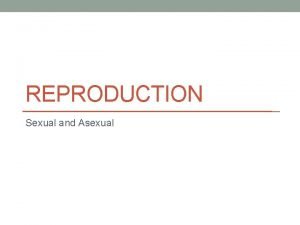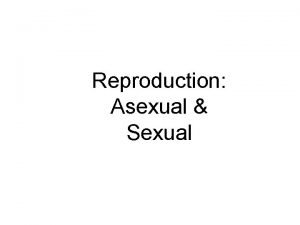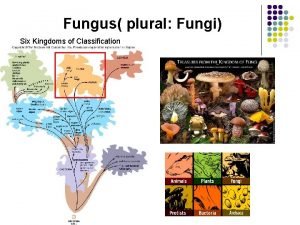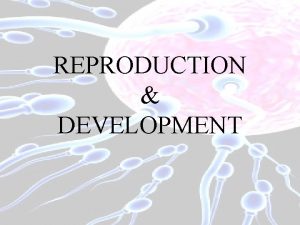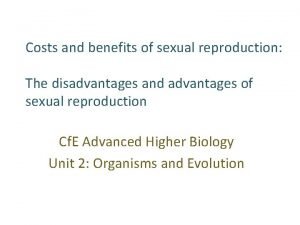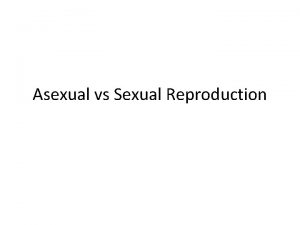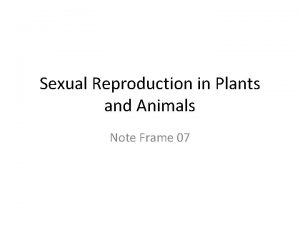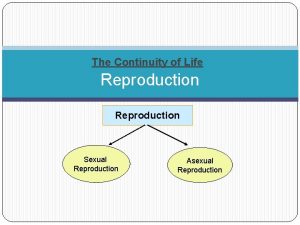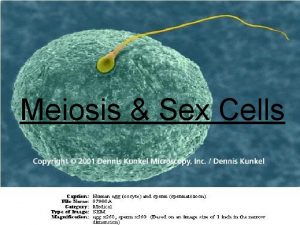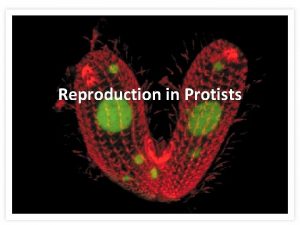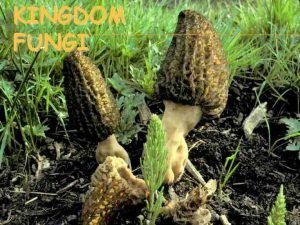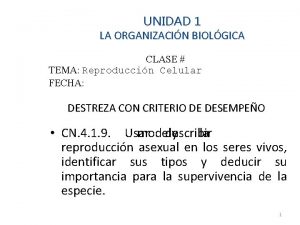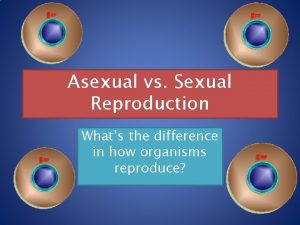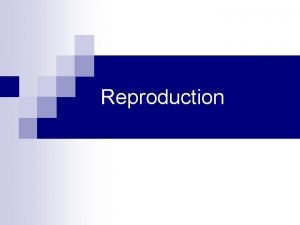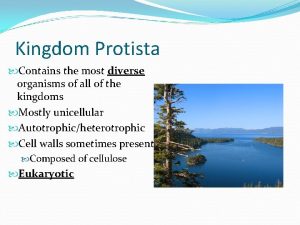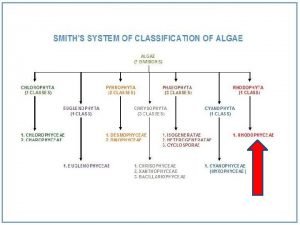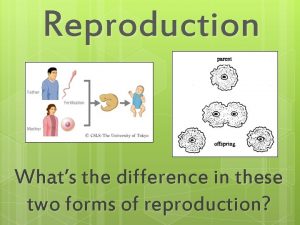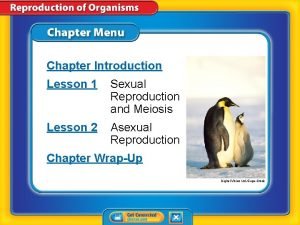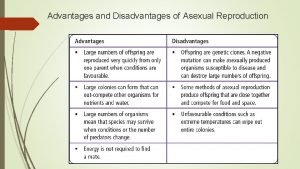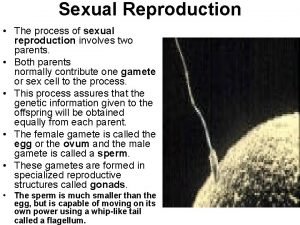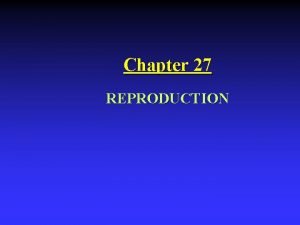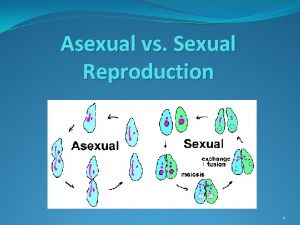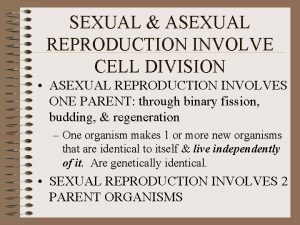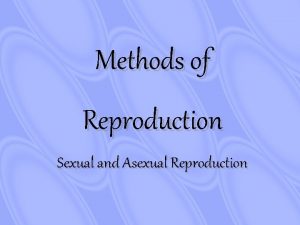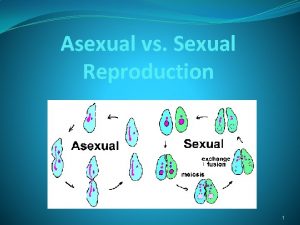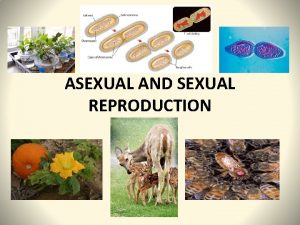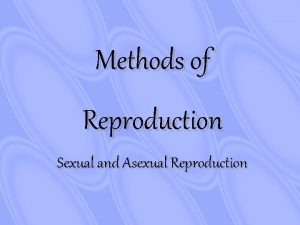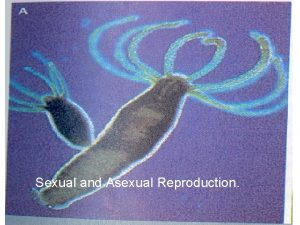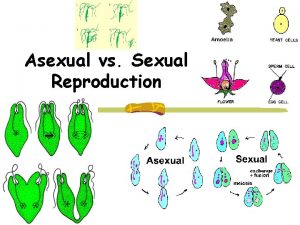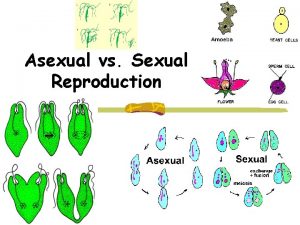Reproduction Asexual vs Sexual What is asexual reproduction


































- Slides: 34

Reproduction: Asexual vs. Sexual

What is asexual reproduction? One parent producing an offspring identical to itself.

Genetic Variation There is no variation in genetics. The offspring are identical to parent.

In What Type of Organisms does asexual reproduction occur? Single celled organisms, (bacteria) The body cells of multi-cellular organisms, (ALL Non-Sex Cells!)

Example: Skin cells reproducing Bacteria dividing

Asexual Reproduction: Purpose: Produce genetically identical offspring

Advantages of Asexual Reproduction Quick, Simple, Offspring are identical to the parent (Ex. Skin cells produce skin cells!)

Disadvantages of Asexual Reproduction NO DIVERSITY! What can harm one organism, can harm all!

Binary Fission A form of asexual reproduction used by all prokaryotes

Mitosis

Cell Division: Mitosis Process: Cell division Purpose: Create two genetically identical cells Cells types: Body Cells / Somatic Cells (ALL Non-Sex Cells)

Cell Division: Mitosis Type of Reproduction: Asexual # of Parent Cells: One # of Daughter Cells (Offspring): Two Genetic Material: Offspring DNA is Identical to parent

Cell Division: Mitosis Types of Organisms: Single-Celled organisms, bacteria, Body cells # of Cell Divisions: One

Cell Division: Mitosis Sets of Chromosomes: Full (2 n), Diploid (Human= Start 46, End 46) # of Chromosomes: Full (2 n), Diploid Amount of DNA: Full, complete set of organisms chromosomes

Mitosis How non-sex cells reproduce (skin, intenstine, blood etc) Starts with one parent cell Ends with two daughter cells Daughter cells are genetically identical

Sexual Reproduction & Meiosis

Sexual Reproduction What is it? Creating a new organism by combining the genetic material of two organisms.

Sexual Reproduction Genetic Variation The offspring is genetically unique from either parent

Sexual Reproduction What organisms reproduce sexually? (& Examples) Multi-cellular organisms: Plants & Animals

Sexual Reproduction Purpose Create genetically diverse offspring.

Sexual Reproduction Advantages A diverse population can better adapt to changes in the environment & avoid extinction

Sexual Reproduction Disadvantages -Takes longer to produce offspring -Need to find a mate


Meiosis: Creating Sex Cells

Meiosis Process: Sex Cell Division Purpose: Create sex cells (gametes) Type of Cell: Gametes (sperm & egg) Type of Reproduction: Sexual

Meiosis # of Parent Cells: 1 # of Daughter Cells: 4 Genetic Material At End: Each of the 4 daughter cells will be unique from the parent and other daughter cells

Meiosis Type of organisms: Multi-cellular organisms; male and female # of Cell Divisions: 2

Meiosis Sets of Chromosomes: Creates cells with 1 set of chromosomes. Known as ‘haploid cells’ (1 n)

Meiosis # of Chromosomes: Sex cells have half the # of chromosomes as somatic cells (Human: 23 sperm, 23 egg)

Meiosis Amount of DNA: Half the amount of DNA (haploid, 1 n)


13. Genetic Variation: Crossing Over Crossing over = Chromosome pairs exchanging segments of DNA This creates genetic variation.

Oogenesis- formation of ovum (egg cells) Female mammals are believed to be born with finite number of potential eggs 7 million at 20 weeks of gestation 1 -2 million at birth 400, 000 at puberty ~500 will be released in their lifetime Few if any complete meiosis

Spermatogenesis- formation of sperm cells Begins at puberty, ends at death One spermatocyte yields four spermatazoa Process takes about 64 days 170 million sperm made a day
 Hare lynx
Hare lynx Asexual reproduction vs sexual reproduction venn diagram
Asexual reproduction vs sexual reproduction venn diagram Binary fission in bacteria
Binary fission in bacteria Sexual reproduction
Sexual reproduction Advantages of genetic diversity
Advantages of genetic diversity Difference between sexual and asexual reproduction
Difference between sexual and asexual reproduction Fungi is plural or singular
Fungi is plural or singular Asexual or sexual reproduction
Asexual or sexual reproduction Asexual and sexual reproduction venn diagram
Asexual and sexual reproduction venn diagram Example of asexual reproduction
Example of asexual reproduction Sexual or asexual reproduction
Sexual or asexual reproduction Sexual and asexual reproduction
Sexual and asexual reproduction Venn diagram sexual and asexual
Venn diagram sexual and asexual Sexual or asexual reproduction
Sexual or asexual reproduction Mitosis and meiosis
Mitosis and meiosis Where does cactus store water
Where does cactus store water Animal sexual reproduction
Animal sexual reproduction Sexual or asexual reproduction
Sexual or asexual reproduction Bacteria sexual or asexual
Bacteria sexual or asexual Do protists reproduce asexually
Do protists reproduce asexually Club fungi characteristics
Club fungi characteristics Etapas de la reproducción humana
Etapas de la reproducción humana Requires two parents
Requires two parents Whats sexual reproduction
Whats sexual reproduction Sexual reproduction
Sexual reproduction Internal fertilization
Internal fertilization Sexual reproduction
Sexual reproduction Diagram of rhodophyta
Diagram of rhodophyta Whats asexual reproduction
Whats asexual reproduction Connecting the concepts sexual reproduction
Connecting the concepts sexual reproduction A sexual reproduction in plants
A sexual reproduction in plants Sexual reproduction
Sexual reproduction Disadvantages of sexual reproduction
Disadvantages of sexual reproduction What is sexual reproduction
What is sexual reproduction What animal is asexual
What animal is asexual



